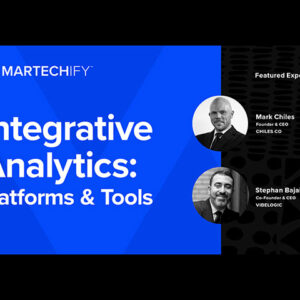Speed Layers: The Missing Link Between Marketing Content and Sales Success
- Brian Lambert, PhD, Amazon Best-Selling Author and Startup Founder
- Content Strategy and Marketing, Data Management and Analytics, Digital Transformation, Managing Org Transformation, Martech Stacks, Sales and Marketing Orchestration
What if your marketing and sales teams could access AI-powered customer insights in real-time, anticipate buyer needs before they arise, and deliver personalized content that truly resonates?
We interviewed Brian Lambert, AI product leader and bestselling author of “The AI Lead,” who reveals why speed layers are the foundation for this transformation.
We interviewed Brian Lambert, AI product leader and bestselling author of “The AI Lead,” who reveals why speed layers are the foundation for this transformation.
Check out the full interview with Brian, where he shares insights on the evolution of sales and marketing in the AI era, the role empathy plays in sales, the concept of purple-collar workers, and speed layers—the missing link between marketing content and sales.
Why traditional marketing content fails to drive sales
Marketing teams invest significant resources creating content that often goes unused by sales teams. As Brian explains, “Most organizations realize that marketing creates content that salespeople don’t use. Most enablement teams create content that nobody takes, nobody uses, and everybody knows these things, but it’s like the treadmill you can’t get off of.”
Key problems with current approaches:
– Content is created with an “inside-out” bias focused on products
– Sales teams develop their own “shadow” materials that actually work
– Marketing operates in disconnected silos
– Content doesn’t map to real buyer problems and decision processes
Key problems with current approaches:
– Content is created with an “inside-out” bias focused on products
– Sales teams develop their own “shadow” materials that actually work
– Marketing operates in disconnected silos
– Content doesn’t map to real buyer problems and decision processes
What is a speed layer?
A speed layer is an AI-powered infrastructure that connects data producers—human and technical sources—with data consumers like employees, customers, or other systems. This enables real-time content creation and delivery.
“You can think of it as a concept of data producers,” Brian explains. “Most organizations produce data with a variety of human and technical sources. So a software application can be a data producer and hardware can produce logs, traces, and telemetry.”
Essential components of a speed layer:
– Data ingestion and organization systems
– Security and governance controls
– Machine learning and observability tools
– Generative AI capabilities
– Integration with existing tools and workflows
“You can think of it as a concept of data producers,” Brian explains. “Most organizations produce data with a variety of human and technical sources. So a software application can be a data producer and hardware can produce logs, traces, and telemetry.”
Essential components of a speed layer:
– Data ingestion and organization systems
– Security and governance controls
– Machine learning and observability tools
– Generative AI capabilities
– Integration with existing tools and workflows
How speed layers transform marketing and sales alignment
The traditional marketing model of creating content and “throwing it at the wall” to sales is becoming obsolete.
Brian argues that “Smart marketing organizations will realize that their job is to feed the AI, not fix salespeople. And when you start feeding the AI with the right type of content that allows salespeople to get what they need, you’re in a different zip code of what it means to create value for customers.”
Brian argues that “Smart marketing organizations will realize that their job is to feed the AI, not fix salespeople. And when you start feeding the AI with the right type of content that allows salespeople to get what they need, you’re in a different zip code of what it means to create value for customers.”
Real-world applications of speed layers
Speed layers are already transforming industries by dramatically accelerating critical business processes. Brian shares two compelling examples:
“In the pharmaceutical space, it’s about decreasing paperwork processes and getting your drug to market faster by fast-tracking regulations compliance. That’s an area where a speed layer is being deployed to bring drugs to market faster.”
Another example comes from patent law: “Deploying a speed layer that speed reads the patents—and the visuals that go with them—allows you to search those patents faster… and instead of spending weeks doing research, it happens in seconds.”
Key benefits of speed layer implementation:
– Accelerated time-to-market
– Reduced manual research time
– Enhanced regulatory compliance
– Improved decision-making accuracy
– Better resource allocation
“In the pharmaceutical space, it’s about decreasing paperwork processes and getting your drug to market faster by fast-tracking regulations compliance. That’s an area where a speed layer is being deployed to bring drugs to market faster.”
Another example comes from patent law: “Deploying a speed layer that speed reads the patents—and the visuals that go with them—allows you to search those patents faster… and instead of spending weeks doing research, it happens in seconds.”
Key benefits of speed layer implementation:
– Accelerated time-to-market
– Reduced manual research time
– Enhanced regulatory compliance
– Improved decision-making accuracy
– Better resource allocation
The role of marketing in the speed layer era
Marketing’s function is evolving from content creation to AI enablement. Brian emphasizes: “I think there’s going to be a day where marketing moves away from creating 100% of the content for buyers. Instead, marketers can work with AI to multiply the impact and accuracy of content in a way that sales teams will actually use.”
Critical shifts in marketing responsibilities:
– Creating content that buyers can use internally
– Building assets that prospects share with their teams
– Feeding AI systems with high-quality data
– Managing the knowledge repository
– Orchestrating personalized content experiences
Critical shifts in marketing responsibilities:
– Creating content that buyers can use internally
– Building assets that prospects share with their teams
– Feeding AI systems with high-quality data
– Managing the knowledge repository
– Orchestrating personalized content experiences
Breaking down silos with speed layers
Traditional organizational structures often impede effective content flow. Speed layers break down these barriers by “taking the content and information you’ve ingested and creating things with it so that it can be handed off to a data consumer,” Brian explains. This creates a unified system where “data producers and consumers get every drop of value out of your data.”
Essential considerations for implementation:
– Identify key data producers across the organization
– Map data flows and handoff points
– Establish governance frameworks
– Define success metrics
– Train teams on new workflows
– Map data flows and handoff points
– Establish governance frameworks
– Define success metrics
– Train teams on new workflows
The future of speed layers and AI-enabled sales: bots and “purple collar workers”
According to Brian, we’re entering a fundamental shift in how organizations operate: “We are in the first AI age. The entire way organizations and people will work 10 years from now will be different. You will have AI bots as team members. You will have AI creating the first draft for you.”
This transformation requires what Brian calls “purple collar workers”—professionals who blend technical knowledge with creative skills. “I’m very passionate about what I call purple collar work, which is a blend of technical and creativity, giving people the digital literacy to realize what’s happening here.”
Key predictions for the future:
– AI agents becoming integrated team members
– Real-time personalized customer microsites
– Automated first-draft content creation
– Enhanced buyer journey orchestration
– Dynamic content adaptation
This transformation requires what Brian calls “purple collar workers”—professionals who blend technical knowledge with creative skills. “I’m very passionate about what I call purple collar work, which is a blend of technical and creativity, giving people the digital literacy to realize what’s happening here.”
Key predictions for the future:
– AI agents becoming integrated team members
– Real-time personalized customer microsites
– Automated first-draft content creation
– Enhanced buyer journey orchestration
– Dynamic content adaptation
Getting started with speed layers
The path to implementation starts with data literacy. As Brian emphasizes: “No data, no AI. Find a friend in your data organization and beef up your data side because you cannot do enterprise AI without that data.”
Essential first steps:
– Audit existing data sources
– Identify key stakeholders
– Start small with pilot programs
– Build cross-functional teams
– Invest in employee training
Essential first steps:
– Audit existing data sources
– Identify key stakeholders
– Start small with pilot programs
– Build cross-functional teams
– Invest in employee training
Overcoming implementation challenges
Organizations face two primary hurdles when deploying speed layers:
“Problem number one is they don’t have the data to run AI,” Brian explains. “The second issue will be the people. Untrained people and lack of data are why 80% of transformations fail.”
Success strategies:
– Focus on data quality and governance
– Provide comprehensive training
– Start with small wins
– Build executive support
– Measure and communicate results
“Problem number one is they don’t have the data to run AI,” Brian explains. “The second issue will be the people. Untrained people and lack of data are why 80% of transformations fail.”
Success strategies:
– Focus on data quality and governance
– Provide comprehensive training
– Start with small wins
– Build executive support
– Measure and communicate results
The time to act is now
The pace of change is accelerating rapidly. As Brian warns: “The time compression on this is massive. Look at what’s already happened in two years since Generative AI came out… You can take the long game and believe that this isn’t going to affect you, but I guarantee you that’s going to be short-sighted.”
Organizations that embrace speed layers now will gain a significant competitive advantage in the AI age. The question isn’t whether to implement speed layers, but how quickly you can begin the transformation.
To learn more about implementing speed layers, visit AIleadbook.com or connect with Brian Lambert on LinkedIn.
Organizations that embrace speed layers now will gain a significant competitive advantage in the AI age. The question isn’t whether to implement speed layers, but how quickly you can begin the transformation.
To learn more about implementing speed layers, visit AIleadbook.com or connect with Brian Lambert on LinkedIn.













